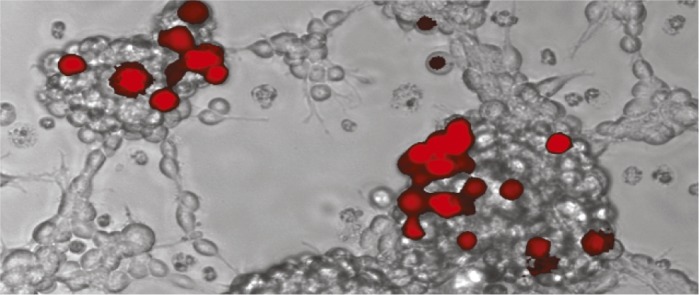Nanoparticle-based solar sterilizing devices

Standalone solar autoclave with parabolic dish collector.
Steam-based sterilization devices, or autoclaves, are one of the most effective tools for destroying infectious pathogens on objects or in liquids, but conventional autoclaves require large amounts of energy to operate. Oara Neumann et al. (pp. 11677–11681) developed two compact, solar autoclaves using gold nanoparticles that, when suspended in water and exposed to sunlight, rapidly dissipate their heat and vaporize surrounding water molecules while barely increasing the temperature of the entire liquid. After prolonged sunlight absorption, however, the nanoparticles cause the water to boil, and the combination of steam produced directly by the nanoparticles and by conventional boiling results in higher steam temperatures than can be achieved without nanoparticles. The authors developed two prototype autoclaves that produced steam at temperatures between 115 and 132 °C for time periods sufficient to sterilize—in accordance with sterilization guidelines defined by the US Food and Drug Administration—liquid or solid materials contained within the units’ sterilization chambers. According to the authors, the devices may prove useful for sanitizing medical instruments and equipment as well as human and animal waste in remote, resource-limited locations, and could be expanded to provide steam for direct use in water purification, cooking, waste remediation, or electricity generation. — N.Z.
Southern Europeans’ genetic diversity explained by gene flow from North Africa

Alhambra, Spain: North African influence in southwestern Europe. Image courtesy of Esperanza Jiménez.
Compared with people in northern Europe, southern Europeans harbor a higher level of genetic diversity. One theory proposed to explain the difference in diversity suggests genetic exchange between Africa and southern Europe, based on the analysis of mitochondrial and autosomal DNA that pointed to gene flow from sub-Saharan Africa to Europe. Reckoning the geographic barrier of the Sahara Desert and the proximity of North Africa to southern Europe, Laura Botigué et al. (pp. 11791–11796) reasoned that gene flow from Africa to Europe likely originated in North Africa. The authors analyzed genetic variations called single-nucleotide polymorphisms, or SNPs, from 2,099 individuals in 37 populations across North Africa and southern Europe, and found that previous reports may have underestimated the shared ancestry between people in the two regions, if gene flow from North Africans, rather than sub-Saharan Africans, is taken into account. The authors report that ancestry is primarily shared with people from the Maghreb, the northwestern region of North Africa. In addition, the authors also found that the shared ancestry is independent of recent gene flow from the Near East into both regions. Drawing on a database of disease risk alleles, the authors found that the predicted genetic risk among Europeans for most of 134 diseases was consistent with the authors’ proposed migration pattern from North Africa to Europe. According to the authors, accounting for shared genetic ancestry is important for the accurate estimation of genetic disease risk. — P.N.
Feed containing designer antibodies may boost livestock immunity

Designer antibodies for livestock.
Researchers have explored various ways of reducing antibiotic use in livestock. One promising strategy uses designer antibodies to extend the immunity conferred by breast milk long after animals have weaned. Vikram Virdi et al. (pp. 11809–11814) adapted this concept to prevent postweaning diarrhea in piglets, a condition caused by infection with enterotoxigenic Escherichia coli (ETEC). The authors supplemented animal feed with seeds engineered to express immune-boosting antibodies. Bacteria-fighting antibodies fit for oral consumption were designed by fusing the variable domains of anti-ETEC antibodies from llama with portions of pig IgG or IgA that mediate antibody attachment to immune cells. The engineered antibodies were then coexpressed with other antibody components in seeds of the model plant, Arabidopsis thaliana. In laboratory tests, IgG- and IgA-based seed extracts prevented ETEC from binding to cells lining the pig gut. However, only pigs that consumed feed supplemented with IgA-producing seeds were protected against ETEC, the authors report. The protected pigs shed fewer bacteria in their feces, mounted reduced immune responses, and gained more weight than other pigs. In light of these findings, the authors conclude that IgA-supplemented feed reduces exposure to the ETEC pathogen. According to the authors, this strategy could be adapted to help prevent recurring economic losses to the livestock industry and possibly prevent human enteric infections. — A.G.
Gut bacteria aids corn pest adaptation to crop rotation
The western corn rootworm (WCR) is a major pest whose adult beetles feed on corn foliage and ears while the larvae eat corn roots, causing severe injury to the plant. Although annual crop rotation between corn and soybean can prevent survival of larvae that hatch in soybean fields, within just 20 generations, a rotation-resistant form (RR-WCR) whose beetles display greater mobility and enhanced survival on soybeans compared to the wild-type form (WT-WCR) has emerged. To investigate the role of gut bacteria in WCR adaptation to soybeans, Chia-Ching Chu et al. (pp. 11917–11922) collected RR- and WT-WCR from fields in four Midwestern states and characterized their gut microbiota. Comparison of ribosomal DNA from WT and RR gut flora revealed characteristic differences in the relative abundance of microbial taxa between the two populations. The authors found that, compared with WT-WCR beetles, RR-WCR beetles had greater microbial diversity in their guts, greater mobility, enhanced survival on soybeans, and higher levels of a gut cysteine protease associated with survival on soybeans. The observed differences in survival on soybeans and cysteine protease activity disappeared when beetles were fed a cocktail of antibiotics, suggesting that bacteria are responsible for these phenotypes. According to the authors, this work demonstrates an active role for microbiota in the evolutionary response of insects to dietary stress. — C.B.
Oncolytic virus therapy for brain tumors

Oncolytic virus infection (red) of mouse glioblastoma stem cell spheres.
Glioblastoma is an aggressive adult brain tumor that is inevitably fatal, and attempts to treat this cancer have been hampered by the lack of a suitable tumor model to evaluate potential therapies. Tooba Cheema et al. (pp. 12006–12011) describe a glioblastoma stem cell (GSC) model that recapitulated the heterogeneity, vasculature, and immunosuppressive microenvironment of glioblastoma tumors in immunocompetent mice. The authors used the model to test an oncolytic herpes simplex virus that was genetically engineered to express mouse interleukin 12 (IL-12), a proinflammatory cytokine involved in innate and adaptive immunity. The resulting virus, G47Δ-mIL12, infected and killed mouse GSCs in vitro, and inhibited mouse tumor growth in vivo. Intratumor injections of G47Δ-mIL12 significantly enhanced the survival of mice bearing intracerebral tumors and increased production of IFN-γ, a cytokine critical for innate and adaptive immunity. The virus also inhibited the formation of new blood vessels and reduced the number of immunosuppressive regulatory T cells in the tumors. The researchers found that T cells, but not natural killer (NK) cells, played a critical role in the G47Δ-mIL12-mediated enhancement of mouse survival. The study demonstrates how an IL-12–expressing oncolytic virus can be used to target GSCs and the tumor microenvironment, and provides insight toward the development of a treatment for glioblastoma. — S.R.
Voice perception and autism spectrum disorders

Brain scans of children with ASD showing weak connections between voice-selective regions and reward pathways.
Previous studies have shown that insensitivity to the human voice may underlie the hallmark communication deficits of autism spectrum disorders (ASD). One prominent theory holds that functionally impaired reward and emotional systems impede children with ASD from actively responding to speech. To investigate how ASD affects voice perception, Daniel Abrams et al. (pp. 12060–12065) compared resting-state fMRI data from 20 children with ASD with typically developing children matched for age and IQ. Focusing on the posterior superior temporal sulcus (pSTS), a brain region selective for the human voice, the authors found patterns of relatively weak connectivity in the ASD subjects between the left-hemisphere pSTS and the dopaminergic reward pathway. In addition, the authors observed ASD-related underconnectivity between the right-hemisphere pSTS, implicated in speech cadence and intonation, and brain regions critical for emotion-related associative learning. Further, the authors report, the degree of underconnectivity between voice-selective cortex and reward pathways predicted the severity of communication deficits in the children with ASD. The findings suggest that weak connectivity between speech and reward centers impede children with ASD from experiencing speech as pleasurable, thus influencing how social communication skills develop, according to the authors. — T.J.


